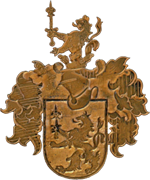The Anjous and the Pauline
After decades of fighting the Anjou Charles I of Hungary, the grandson of Mary of Hungary, the daughter of Stephen V of Hungary, acquired the Árpáds’ throne. During the following decades he conquered the regional oligarchs. In 1342 his son Louis the Great inherited a solid throne. His mother the great-granddaughter of Béla IV from the polish Piast dynasty is Elizabeth of Poland. In 1370 he becomes King of Poland by her right. After the assassination of his brother Andrew he claims the Kingdom of Naples as his inheritance. During his reign has Hungary its biggest expanse. According to an adage “His kingdoms border is washed by three seas.”. Those were the Adriatic Sea at Dalmatia, the Black Sea at the subservient principalities of Moldavia and Wallachia and almost the Baltic Sea. Almost meaning with the exception of a small land strip occupied by the Teutonic Knights in northern Poland. He has to engage in skirmishes with the Turks. Queen Mary of Hungary, oldest daughter of Louis I, married Sigismund of Luxemburg, who later becomes the emperor of the Holy Roman Empire. Louis’ younger daughter Saint Jadwiga of Poland marries Wladyslaw II Jagello. Making Lithuania Christian, and becoming the ancestress of the Jagello dynasty.
The Order of Saint Paul the First Hermit the white monks more commonly known as Paulines are the only Hungary-based order. They have been founded under Béla IV. It is not a militant order but battle hardened physically fit men are joining in force. Their idol is the paladin king Saint Ladislaus I of Hungary. Louis I founds many Pauline monasteries the most famous being the Márianostra founded in 1352. He acquires the relic of Saint Paul the Hermit and places it in the grand abbey of Szentlőrinc. Vladislaus II of Opole relative and palatine (vice king) of Louis I founds the first polish monastery near Czestochowa at Jasna Gora.
He donates the famous icon Black Madonna of Czestochowa and on her cloak the Anjou lily is visible. The icon is also known as Regina Poloniae, the Queen of Poland. Its copy was placed in almost every Pauline monastery. Czestochowa became a polish national sanctum. Nowadays it is visited by a million pilgrims each year. At the time of founding 16 monks arrived from Márianosztra to guard the holy icon and started the Pauline order in Poland. Up until the Turk invasion they had 200 monasteries around the world. Pope Alexander VI, the famous Borgia, asked them to mark the borders of the Spanish and Portuguese colonial empires. They were the New World‘s first missionaries. They were later replaced by the Jesuits. At this high point did the Ottoman came upon us and ruined not only our country but the Paulines too. Cardinal George Martinuzzi (+1551) the founder of the Principality of Transylvania also was a member of this order. From the 17th century onward constructions were strengthened. In the 18th century the Pauline order’s “net worth” was more than 4,5 million Rhenish guilder. To the good operation of the Pauline farmlands contributed their financial aptitude and social sensitivity. For example they lent money on smaller interest rates than others; moreover the poor could get interest-free loans. Their philosophy was based on the teachings of Aristotle and Saint Thomas of Aquino, and last but not least on the strong Hungarian intellectuality of the order, this was the “Pauline spirit”. In 1786 Joseph II bans the Pauline order among the other orders deemed useless. They continued to operate in secrecy. Before the ban the general prior makes the pope take out the polish ordinal territory from under his supervision, so the order can live on outside the Habsburg empire. In 1934 inside the Gellért Hill Cave chapel the Pauline order restarts in the mother country. In 1950 the chapel was shut down by the communist regime and a 2 meter wide concrete wall was erected in front of its entrance. In 1989 after the End of Communism the Hungarian territory could reform itself and the Cave Chapel could slip out once again. Pécs becomes the orders center with a monastery functioning also as a boarder teaching house. They got back their houses at Márianosztra and Petőfiszállás. In 2008 the Hungarian Pauline order had 22 members.
My sweet home Hungary you will prosper and decline together with the Pauline.
Péter Pázmány



